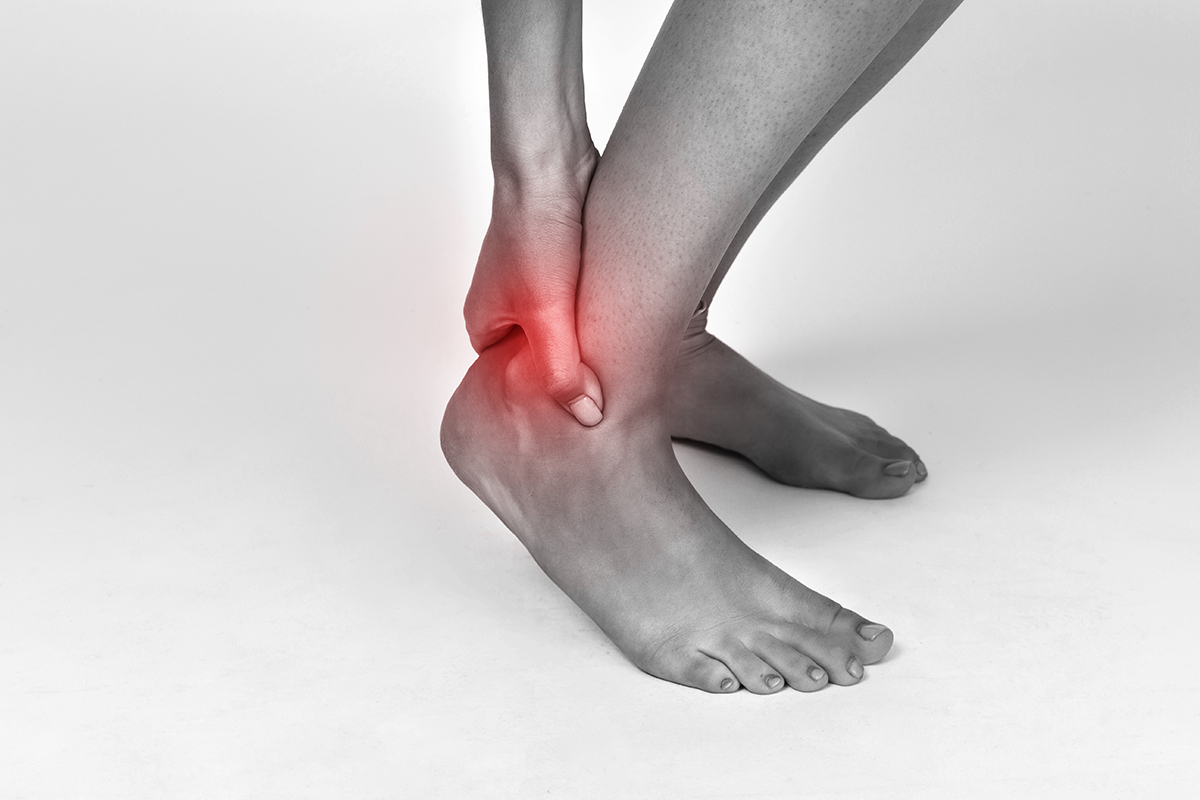
 Sprained your ankle? We can help.
Sprained your ankle? We can help.
Ankle sprains can affect anyone at any age. When you sprain your ankle, you injure the ligaments that connect the bones at the ankle joint. These ligaments are responsible for helping stabilise and support the ankle.
Inversion sprains, where the foot is twisted inwards and you roll outwards onto your ankle, account for approximately 85% of ankle sprains. Inversion injuries usually only affect the ligaments on the outside of the ankle, which are the:
- Calcaneofibular ligament
- Anterior talofibular ligament
- Posterior talofibular ligament
Any activity that causes the ankle to roll forcefully can cause a sprain. These activities can range from simply losing your balance or walking on uneven ground to landing incorrectly during sports or rapidly changing direction from side to side.
How do you know if you sprained your ankle?
Your foot will twist inwards and then you’ll feel symptoms immediately, including pain at the ankle, difficulty walking on the ankle, swelling at the ankle joint, and stiffness. Any activity that twists the foot inwards will exacerbate the pain.
What does a sprained ankle look like?
Once you sprain your ankle, it is likely to swell and may become red or bruised. The swelling should subside but the bruising may remain much longer. If there is no bruising, then the ankle may look normal, but be very painful to walk on.
How to treat a sprained ankle
Despite most people shrugging off ankle sprains without properly caring for them, ankle sprains not effectively managed may lead to long-standing ankle instability.
The first step to managing an ankle sprain is to use R.I.C.E (rest, ice, compression and elevation) to help reduce the painful symptoms. Swelling can contribute significantly to pain, so reducing your swelling should help reduce your pain too.
Your podiatrist can help you support and stabilise your ankle while relieving tension away from the injured ligaments. Treatment may involve strapping the ankle, using an ankle brace, orthotics, and ensuring you’re wearing the right footwear that won’t increase your risk of sustaining another sprain. Ultimately, the goal is to both allow the ligaments to heal so you can get back to normal movement, as well as reducing the likelihood of another ankle sprain in the future by addressing the cause of your current sprain.
How long does a sprained ankle take to heal?
This depends greatly on the severity of your injury and a number of other factors, like how quickly you start proper care and recovery.
- A mild ankle sprain takes approximately 3 weeks to heal (between 2-5 weeks)
- A moderate ankle sprain may take 4 weeks (between 3-6 weeks)
- A severe ankle sprain may take up to 6 months to heal (between 2-6 months)
The sooner you start caring for your ankle and helping it heal, the faster your recovery.
Ankle Sprains FAQs
How long does a sprained ankle stay swollen?
Immediately after your injury, your ankle may swell in response to the injury and may stay swollen for up to a few days. If you apply ice, compression or take oral anti-inflammatories, these will work to reduce your swelling and it will subside much faster. While swelling is uncomfortable and painful, it is a natural part of the healing and repair process.
Can walking on a sprained ankle make it worse?
Sometimes, when walking is resumed too early. When your ankle is sprained, there is damage to one or more of the ligaments responsible for keeping your ankle stable and well-controlled. When these ligaments are damaged, they are weakened, and cannot perform their job as well. This means you may be more likely to sprain your ankle further, or pull on the damaged ligaments and cause further damage to the existing injury.
On the other hand, studies have shown that staying mobile during your recovery and bearing weight on the ankle when safe and comfortable to do so (as opposed to complete immobilisation with a boot or crutches) has been shown to aid recovery.
Can a sprained ankle cause fever?
It is not uncommon for your ankle to feel hot after a sprain, especially when you have notable swelling or redness. Ankle sprains, however, do not normally cause a systemic fever. Fever is usually an indication that you have an infection somewhere in your body. If you develop a fever, seek help from your GP immediately.
Can you put heat on a sprained ankle?
Yes, just not within the first 48-72 hours of the sprain or while there is still significant swelling. This is the time where ice is most often used to help reduce the swelling and relieve some pain. After this, heat can be used to help increase blood flow to the ankle and assist your recovery.
Can you play sports on a sprained ankle?
We do not recommend playing sports on a sprained ankle as you may worsen the severity of your injury, sprain your ankle again, or injure yourself in other ways while guarding your painful ankle.
Do I need an x-ray for a sprained ankle?
X-rays are used to assess changes in bone, whereas ankle sprains affect ligaments which are tissues. Therefore, it is not commonplace to use an x-ray for an ankle sprain. If it suspected that you may also have fractured a bone during your sprain, then an x-ray can be ordered.
To assess the severity of an ankle sprain and how many ankle ligaments have been damaged, ultrasound can be used.
Does a sprained ankle bruise?
Yes, a sprained ankle can bruise, but it doesn’t always. Bruising is just an indication of bleeding beneath the skin as a result of the injury and is not normally an indication of anything more serious.
How long do you keep ice on a sprained ankle?
Ice is usually applied indirectly to the ankle for no longer than 20 minutes at a time, multiple times per day, with a break between applications. Make sure to have a towel or other material between the ice and your skin to help prevent skin burns. Some prefer to have an ice foot bath – the same applies with no more than 20 minutes of immersion.
Should I get crutches for a sprained ankle?
Crutches are generally used when normal walking is made difficult as a result of your ankle sprain, to help you stay mobile. If you are finding this to be the case then crutches may be an option for you, though most people do not require them. As studies have shown that early weight-bearing on the ankle (once the swelling has gone and pain has reduced) has been shown to aid ankle healing, if it is comfortable and safe for you to keep walking without crutches, this may be to your benefit.





